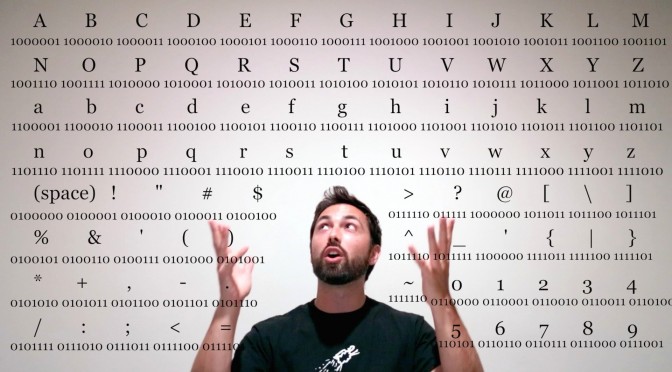Prepare to be amazed by the mind-boggling complexity of genetic information within your body. Within a single cell, among the 40 trillion cells composing your body, lies a genetic code containing approximately 1.5GB of information. But that’s just the beginning. Consider the entirety of your body, and you’ll be astounded to learn that it holds a staggering 60 Zettabytes of information. Yes, you read that correctly – it surpasses the combined volume of all data ever accumulated on Earth until 2020. A captivating video presented by Veritasium.
In the captivating video, Veritasium (Derek Muller) explores the fascinating world of information and its various forms of expression. The discussion begins with an observation about the perception of speed in spoken languages like Spanish and English. Although Spanish may sound faster due to more syllables spoken per minute, it was discovered that the amount of information conveyed in both languages remains nearly identical. This finding highlights the role of cognitive abilities in processing information rather than the characteristics of a specific language.
Shifting the focus to written language, the narrator delves into the visual aspects of Chinese characters and English words. While the square format of Chinese characters may seem more visually efficient, studies reveal that English readers can simultaneously perceive more letters than Chinese readers can characters. However, Chinese characters possess a denser meaning, balancing the reading rates between the two languages at around 380 words equivalent per minute. These observations suggest that the limiting factor in communication speed lies within our cognitive capacity rather than the specific language employed.
To grasp the concept of quantifying information, the video introduces the notion of bits, the smallest units of information. A yes/no question represents the minimum information requirement, corresponding to a single binary digit or one bit. Scaling up, a roll of a six-sided dice with six possible outcomes necessitates three bits to encompass all possibilities. Expanding further to cover the 26 letters of the English alphabet, five bits are needed. However, when considering lowercase letters, punctuation, special characters, and numbers, the total symbol count reaches 95, requiring seven bits for complete encoding. This led to the establishment of the American Standard Code for Information Interchange (ASCII) in 1963, using seven bits to represent each symbol.
Now, turning attention to the human body, the narrator delves into the astonishing amount of information contained within. The genetic code, residing in the DNA sequence of four molecules (T, A, G, and C), can be encoded using two bits per option. Considering the six billion letters comprising an individual’s genome and dividing by eight bits per byte, the total information amounts to approximately 1.5 gigabytes (GB). Remarkably, every cell in the human body, estimated to be around 40 trillion cells, contains a full copy of the genetic code. Consequently, the total information within the human body reaches an astounding sixty zettabytes (60 followed by 21 zeroes), surpassing the amount of digital information on Earth as of 2020.
While this vast amount of information may seem overwhelming, it is worth noting that 99.9% of genetic information is shared among all humans. Less than one part in a thousand is unique to an individual, which implies that the information distinguishing one person from another could potentially be stored in less than a megabyte. To emphasize the contrast, the video highlights the information contained in a video. To precisely define the color of two million pixels, thirty times per second, for the entire duration of the video, approximately 100 gigabytes of information are required. However, advancements in video compression techniques allow high-definition videos to be streamed with considerably smaller file sizes.
Reflecting on the nature of information, the video takes a philosophical turn. The narrator ponders the physicality of information, emphasizing that words spoken or written are not mere abstract concepts but actual vibrations and tangible entities. These vibrations persist, interacting with the environment even after they have been emitted. In theory, one could meticulously observe the world and trace back the information carried by those vibrations by understanding the positions of particles and extrapolating the events that have transpired. This intriguing concept underscores the profound implications of information and its endurance in the physical realm.
In conclusion, the video by Veritasium encompasses a wide range of topics relating to information. It highlights the intricate relationship between language, communication speed, and cognitive abilities. The video also delves into the quantification of information, introducing the concept of bits and their application in representing various symbols and data. The astonishing amount of information stored within the human body, encompassed in the genetic code, is emphasized, along with the mind-boggling scale of 60 zettabytes, surpassing the digital information on Earth.
Moreover, it prompts contemplation about the physicality of information, asserting that information is not just an abstract concept but a tangible entity manifested in vibrations and interactions with the world. The notion that the entirety of past information could be theoretically traced and extrapolated from the current state of particles adds a profound philosophical layer to the discussion, evoking thoughts about the nature of time, causality, and the interconnectedness of events.
Derek not only presents intriguing facts and figures but also encourages viewers to contemplate the intricate complexities and philosophical aspects of information. By elucidating the profound implications and vastness of information, the video provokes a sense of wonder and awe about the mysteries that lie within the human body and the world at large.

